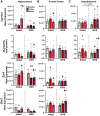Ovarian status modulates endocrine and neuroinflammatory responses to a murine mammary tumor
- PMID: 35993563
- PMCID: PMC9512114
- DOI: 10.1152/ajpregu.00124.2022
Ovarian status modulates endocrine and neuroinflammatory responses to a murine mammary tumor
Abstract
Patients with breast cancer have increased circulating inflammatory markers and mammary tumors increase neuroinflammation in rodent models. Menopausal status is not only important in the context of breast cancer as circulating estrogen influences tumor progression, but also because estrogen is anti-inflammatory and an essential modulator of endocrine function in the brain and body. Here, we manipulated "menopause" status (ovary-intact and ovariectomized) in an estrogen receptor (ER)+ mouse mammary tumor model to determine the extent to which ovarian status modulates: 1) tumor effects on estrogen concentrations and signaling in the brain, 2) tumor effects on estrogen-associated neurobiology and inflammation, and 3) the ability for tumor resection to resolve the effects of a tumor. We hypothesized that reduced circulating estradiol (E2) after an ovariectomy exacerbates tumor-induced peripheral and central inflammation. Notably, we observed ovarian-dependent modulation on tumor-induced peripheral outcomes, including E2-dependent processes and, to a lesser degree, circulating inflammatory markers. In the brain, ovariectomy exacerbated neuroinflammatory markers in select brain regions and modulated E2-related neurobiology due to a tumor and/or resection. Overall, our data suggest that ovarian status has moderate implications for tumor-induced alterations in neuroendocrinology and neuroinflammation and mild effects on peripheral inflammatory outcomes in this murine mammary tumor model.
Keywords: brain; breast cancer; cytokines; estrogen; tumor resection.
Conflict of interest statement
No conflicts of interest, financial or otherwise, are declared by the author.
Figures







References
Publication types
MeSH terms
Substances
Grants and funding
LinkOut - more resources
Full Text Sources

